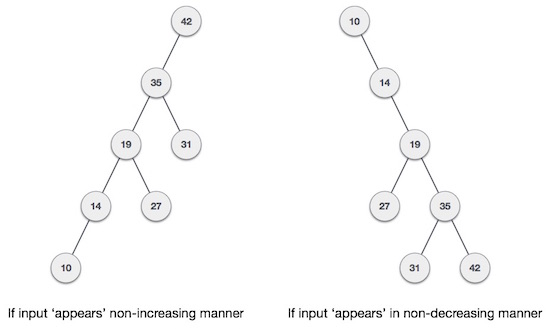AVL tree in data structure and algorithm
What is an AVL tree?
What happens if the data entered into the binary search tree (BST) is in ordered form (ascending or descending). It will look like this:

In general, the worst-case performance of a binary search tree (BST) is close to linear search algorithms, ie Ο (n). With real-time data, we cannot predict the data pattern and its frequencies. Therefore, it is necessary to balance here to balance the existing binary search tree.
The AVL tree (short for the names of A delson inventors, V elski and L andis) is a highly balanced binary search tree. The AVL plants check the height of the left seedlings and the right seedling and make sure that the difference between them is not greater than 1. This difference is called the Balance Factor .
Below is an example of an illustration of three trees in which the first tree is balanced, the second and third are unbalanced.

In the second tree, the tree on the left of C has an elevation of 2 and the right subtree has a height of 0, so the difference is 2. In the third tree, the right subtree of A has the height of 2 and the tree on the left has a height of 0, so the difference is also 2. While the AVL tree only accepts the difference (or Equilibrium factor) of 1.
BalanceFactor = height(left-sutree) − height(right-sutree)
If the difference between the height of the left subtree and the right subtree is greater than 1, the tree is balanced by using some AVL rotation techniques shown below.
Technology of rotating AVL trees
To make the tree balance itself, an AVL tree can perform the following 4 types of rotation techniques:
Left rotation technique
Right turn technique
Left-right rotation technique
Right-to-left spin technique
The first two spinning techniques are single rotation techniques and the other two rotation techniques are rotation techniques.
In the next section, we will explore in detail each rotation technique with simple and easy-to-understand illustrations.
Fruit rotation technique AVL
If a tree becomes unbalanced when a node is inserted in the right subtree of the right subtree, we can perform a single left rotation technique as follows:
In the above illustration, node A becomes unbalanced when a node (node C) is inserted into the subtree to the right of the right subtree of node A. We perform a left-turning technique to make A a tree. left child of B.
The technique turns to the AVL tree
The AVL tree becomes unbalanced if a node is inserted into the subtree to the left of the left subtree. In order to balance the tree, we must make the right rotation as follows:
As shown in the figure, an unbalanced node will become the right subtree of its left seedling by right-turning technique.
Technique turns left-right AVL tree
The rotation technique is quite complicated compared to the two techniques of the single rotation just introduced above. In order to understand this rotation technique faster, you need to note each action that is taken while recording. A left-right rotation technique is a combination of left-turning technique followed by right-turning technique.
Action StatusRight-fruit rotation technology AVL
Another type of rotation technique is the right-to-left rotation technique. This technique is a combination of rotation techniques that must be followed by left-turning techniques.
Action StatusAccording to Tutorialspoint
Previous article: Binary Search Tree (Binary Search Tree)
Next lesson: Spanning Tree in data structure and algorithm
You should read it
- New technique can hack even computers completely isolated from the internet
- What is the Clean Room technique?
- Learn about the Whaling network attack technique
- PrintListener technique: Steal fingerprints just by listening to the sound of swiping the screen
- Cold boot, an attack technique 10 years ago can crack the encryption of most PCs today
- How to use Morphing morphing techniques in Photoshop
- Is it possible to perform the 'bend curve' technique?
- New Wi-Fi chips increase performance by 10 times
- Web8: XSS Exploits - Part 2: Stored XSS
- 2007: Super sophisticated Trojan will be raging
- What is Deepfake?
- How to hide confidential data in images or audio files in just one note
Maybe you are interested
Hydrogen trains run 2,800km on just one tank of fuel How to handle when your computer has an application not found error Joker Wallpaper 4K, Joker 4K wallpaper, beautiful Joker photos Microsoft Azure is being used to host malware and C2 servers 14 things people with strong will often do to achieve success What is N2O gas (laughing gas), how harmful is it?
